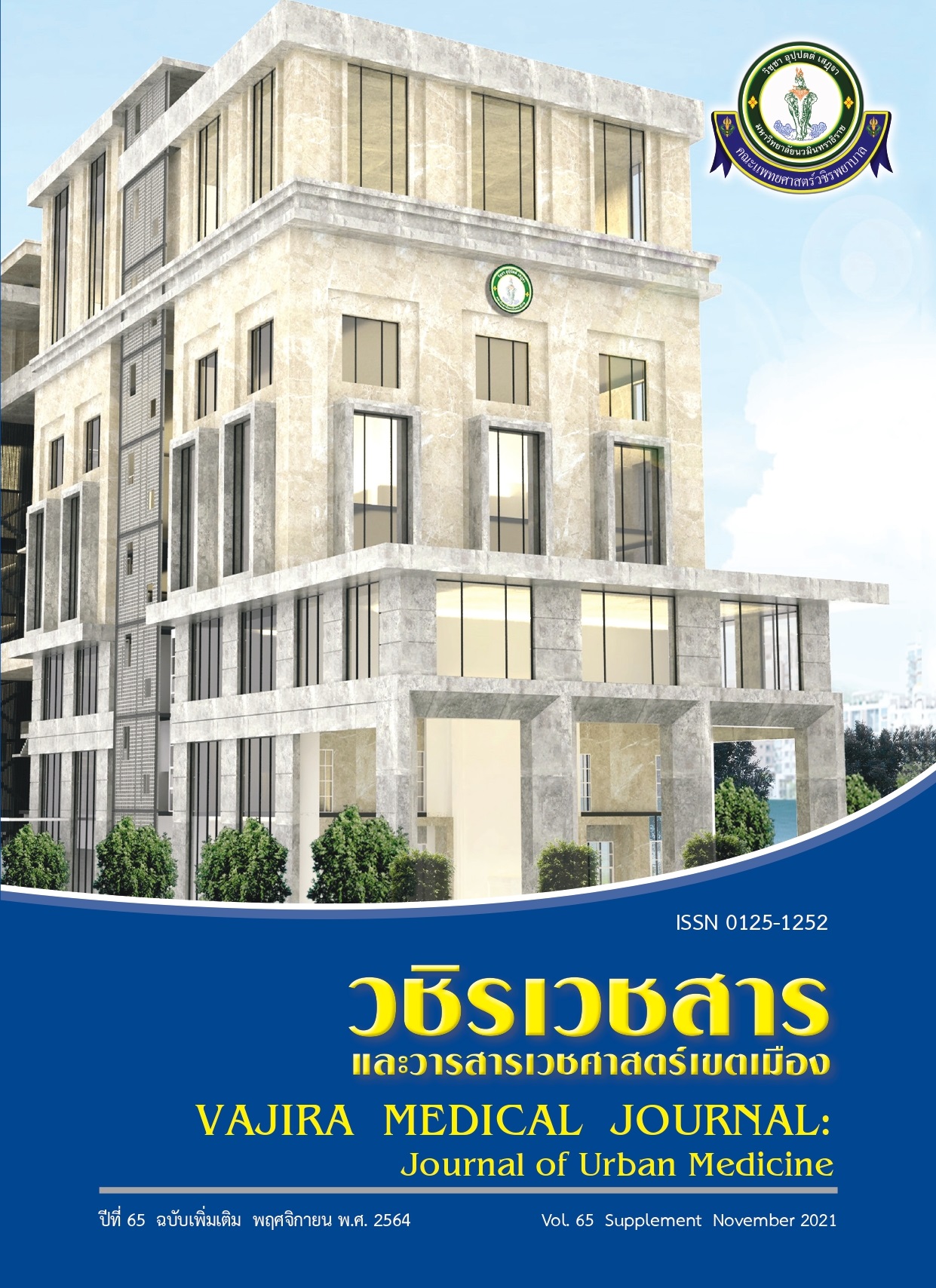Prevalence of Neutropenia in HIV-Infected Patients with Malignancy Receiving Chemotherapy or Radiotherapy
Main Article Content
Abstract
Background: Serious neutropenia is a common complication of chemotherapy and radiation among HIV-infected patients with malignancy leading to morbidities and deaths. This study was intended to investigate the prevalence and risk factors associated with neutropenia in HIV-infected patients with malignancy receiving chemotherapy and/or radiotherapy.
Methods: A retrospective cohort study was conducted by extensive reviewing patients’ medical records. Cancer patients with HIV infection who received medical attendances at Vajira hospital from January 1, 2013 to December 31, 2017 were participated. Clinical data including demographics, cancer types, stages and treatment, and HIV-related factors were collected and analyzed.
Results: There were 39 eligible patients, 20 had AIDS-defining cancers and 19 had non-AIDS-defining ones. The prevalence of all grade neutropenia was 58.9% (23 of 39). Slightly more common in females (61.5%). The median age was 50.53 (IQR 40.92-60.14). Median CD4 cell count prior to cancer diagnosis was 304.9 cells/μL (IQR 175 – 387). Nighty percent of lymphoma patients and all breast cancer patients developed neutropenia after chemotherapy. On the other hand, neutropenia did not occur among HIV-infected cancer patients receiving radiotherapy. Independent risk factors associated with neutropenia included those who aged more than 55 years and had hematologic malignancies. There was no statistically significant association with sex, body mass index, ECOG performance status, comorbidities, prophylactic treatment against opportunistic infection, CD4 count, HIV viral load, and specific type of anti-retroviral drugs.
Conclusion: The prevalence of neutropenia among cancer patients with HIV infection was 58.9%. Most occurred among patients with lymphoma and breast cancer.
Downloads
Article Details

This work is licensed under a Creative Commons Attribution-NonCommercial-NoDerivatives 4.0 International License.
References
Jutrakul P. Worrying situation of Thai adolescents with higher HIV infection [Internet]. 2018 [cited 2019 Jan 27]. Available from: http://www.thaihealth.or.th/Content/41145.
Global information and education on HIV and AIDS. HIV and AIDS in Thailand [Internet]. 2019 [cited 2019 Jan 27]. Available from: https://www.avert.org/professionals/hiv-around-world/asia-pacific/thailand.
Veterans affairs benefits and health care. HIV-related infections and cancers [Internet]. 2019[cited 2019 Jan 27]. Available from: https://www.hiv.va.gov/patient/diagnosis/OI-index.asp.
National cancer institute. Type of cancer treatment [Internet]. 2019[cited 2019 Jan 27]. Available from: https://www.cancer.gov/aboutcancer/treatment/types.
Manus MM, Lamborn K, Khan W, Varghese A, Graef L, Knox S. Radiotherapy-Associated Neutropenia and Thrombocytopenia : Analysis of Risk Factors and Development of a Predictive Model. Blood 1997;89(7):2303–10.
Freifeld AG, Bow EJ, Sepkowitz KA, Boeckh MJ, Ito JI, Mullen CA, et al. Clinical practice guideline for the use of antimicrobial agents in neutropenic patients with cancer : 2010 Update by the Infectious Diseases Society of America. Clin Infect Dis 2011;52(4):e56-93. doi: 10.1093/cid/cir073.
Park J, Kim TM, Hwang JH, Kim NH, Choe PG, Song KH, et al. Risk factors for febrile neutropenia during chemotherapy for HIV-related lymphoma. J Korean Med Sci 2012;27(12):1468–71.
Kiertiburanakul S, Likhitpongwit S, Ratanasiri S, Sungkanuparph S. Malignancies in HIV-infected Thai patients. HIV Med 2007;8(5):322–3.
Ngidi S, Magula N, Sartorius B, Govender P, Madiba TE. Incidence of chemotherapyinduced neutropenia in HIV-infected and uninfected patients with breast cancer receiving neoadjuvant chemotherapy. South Afr Med J Suid-Afr Tydskr Vir Geneeskd 2017;107(7):595–601.
Oken MM, Creech RH, Tormey DC, Horton J, Davis TE, McFadden ET, et al. Toxicity and response criteria of the Eastern Cooperative Oncology Group. Am J Clin Oncol 1982;5(6):649–55.
Rubinstein PG, Aboulafia DM, Zloza A. Malignancies in HIV/AIDS : From Epidemiology to Therapeutic Challenges AIDS 2014;28(4):453–65.
Patel P, Hanson DL, Sullivan PS, Novak RM, Moorman AC, Tong TC, et al. Incidence of types of cancer among HIV-infected persons compared with the general population in the United States, 1992-2003. Ann Intern Med 2008;148(10):728.
Yokoyama M, Kusano Y, Nishihara A, Inoue N, Nishimura N, Mishima Y, et al. Incidence and risk factors for febrile neutropenia in Japanese patients with non-Hodgkin B cell lymphoma receiving R-CHOP: 2-year experience in a single center (STOP FN in NHL 2). Support Care Cancer 2020;28(2):571–9.


